The Art Gallery of Ontario (AGO) is one of
the most distinguished art museums in Canada with a collection of over
80,000 works of art. A renovation in 2008 by Frank Gehry significantly
expanded the museum's gallery space.
The museum is best known for its large collection of Henry Moore
sculptures and for its Canadian holdings, the world's largest, which
includes a comprehensive collection of Inuit art.
From Small-town Gallery to Metropolitan Museum
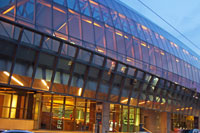
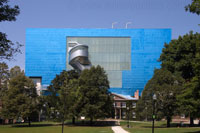
Art Gallery of Ontario
The AGO was founded in 1900. Eleven years later it was able to move into
the Grange, a mansion in what was then the town of York.
The museum, at the time known as the Art Gallery of Toronto expanded quickly, opening new galleries as early as in 1918 and again in 1926 and 1935. Thanks to new acquisitions and donations, the museum continued to expand in the 1970s with the opening of the Henry Moore Sculpture Center and a new Canadian wing. In 1993 another expansion added the Tanenbaum Sculpture Atrium.
The AGO's most ambitious expansion project was launched in 2002, when the acclaimed architect Frank Gehry, who grew up in Toronto, drew up plans for a transformation of the museum complex that would end up increasing its space by almost fifty percent. Gehry not only added the eye-catching glass facade along Dundas Street and the four-story titanium wing facing Grange Park but he also integrated the various existing annexes into a more coherent museum complex with the construction of new walkways, ramps and staircases.
The museum, at the time known as the Art Gallery of Toronto expanded quickly, opening new galleries as early as in 1918 and again in 1926 and 1935. Thanks to new acquisitions and donations, the museum continued to expand in the 1970s with the opening of the Henry Moore Sculpture Center and a new Canadian wing. In 1993 another expansion added the Tanenbaum Sculpture Atrium.
The AGO's most ambitious expansion project was launched in 2002, when the acclaimed architect Frank Gehry, who grew up in Toronto, drew up plans for a transformation of the museum complex that would end up increasing its space by almost fifty percent. Gehry not only added the eye-catching glass facade along Dundas Street and the four-story titanium wing facing Grange Park but he also integrated the various existing annexes into a more coherent museum complex with the construction of new walkways, ramps and staircases.
The Grange
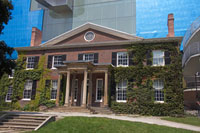
The Grange
Despite the perennial expansion projects the Grange, the original home
of the AGO, is still intact. The Grange is one of Toronto's oldest
buildings; it was built in 1817 by D'Arcy Boulton Jr, a lawyer and
politician, who designed the brick house himself. He lived here with his
wife, eight children and ten servants.
In the mid-nineteenth century the grand house was a gathering place for the upper class and the site of lavish parties. The last owner, Harriet Boulton, bequeathed the house to the Art Gallery. Today you can still access the house from inside the AGO's modern museum building.
In the mid-nineteenth century the grand house was a gathering place for the upper class and the site of lavish parties. The last owner, Harriet Boulton, bequeathed the house to the Art Gallery. Today you can still access the house from inside the AGO's modern museum building.
The Collections
The Art Gallery of Ontario boasts a wide-ranging collection spanning
more than six hundred years, starting from fourteenth century works and
going all the way to contemporary art. It covers paintings, photographs,
prints, drawings and sculpture and has works from all corners of the
world, from Africa and Oceania to Europe and naturally, Canada.
Canadian Art

Baffin Island Mountains
(Lawren Harris)
(Lawren Harris)
The main strength of the Museum is in its comprehensive collection of
Canadian Art. It features many works by the Group of Seven, a group of
landscape painters who were among the first to create a Canadian style
as opposed to mimicking existing European art. Emily Carr, one of
Canada's best known artists, is also well represented.
The museum also boasts an impressive number of works from the Inuit and First Nations, including contemporary works.
The museum also boasts an impressive number of works from the Inuit and First Nations, including contemporary works.
Henry Moore Sculptures
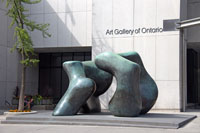
Large Two Forms
(Henry Moore)
(Henry Moore)
Another highlight in the museum is the Henry Moore Sculpture Centre,
which opened in 1974 in a gallery designed with the help of Moore
himself. The British sculptor donated a large number of his sculptures
to the museum, which now owns more than eight hundred of the artist's
works. Besides the famous bronzes there are also plasters, lithographs
and drawings on display.
Outside, at the corner of Dundas and McCaul Streets is another sculpture of Henry Moore, entitled "Large Two Forms".
Outside, at the corner of Dundas and McCaul Streets is another sculpture of Henry Moore, entitled "Large Two Forms".
European Collection
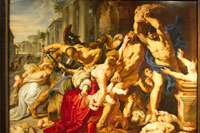
Massacre of the Innocents
(Peter Paul Rubens)
(Peter Paul Rubens)
The European collection of the AGO is quite diverse and spans a period
from the Middle Ages to the mid-nineteen hundreds. Medieval sculpture,
ivory carvings, stained glass windows, Baroque sculpture and paintings
from Italy, France and the Netherlands are all exhibited here.
The main highlight is the 'Massacre of the Innocents' by the Flemish painter Peter Paul Rubens. Also take a close look at 'The Peasant Wedding', a painting by Rubens's fellow townsman Pieter Brueghel the Younger that gives an insight in rural life during the seventeenth century.
The main highlight is the 'Massacre of the Innocents' by the Flemish painter Peter Paul Rubens. Also take a close look at 'The Peasant Wedding', a painting by Rubens's fellow townsman Pieter Brueghel the Younger that gives an insight in rural life during the seventeenth century.
Other Permanent Exhibits
The top floors of Frank Gehry's titanium addition are devoted to
contemporary art. The AGO also owns the largest collections in Canada of
African an Oceanic art. The African gallery contains many wooden
sculptures from west and central Africa while the Oceanic collection
focuses on Aboriginal art and includes hundreds of boomerangs. The
museum also has tens of thousands of photographs as well as prints and
drawings spanning a period from the fifteenth century to the present
day.
- Next: Hockey Hall of Fame
Subway
St. Patrick (Yonge - University)
Location
317 Dundas Street West at McCaul Street



